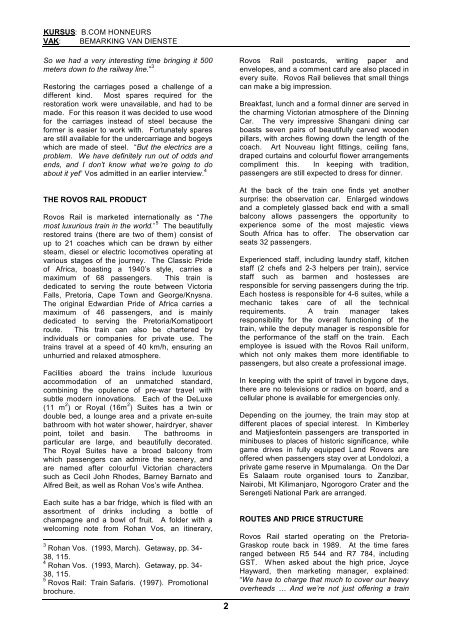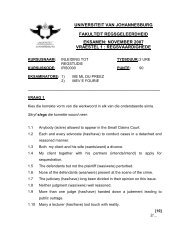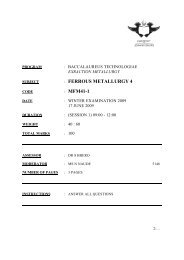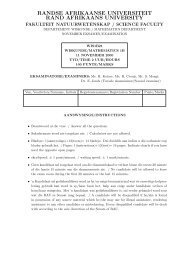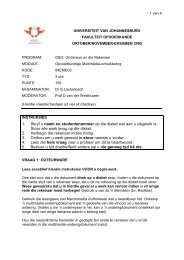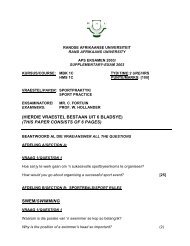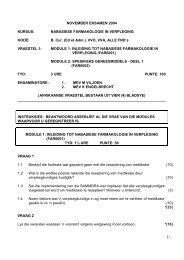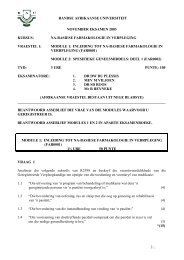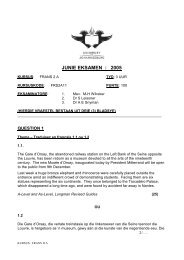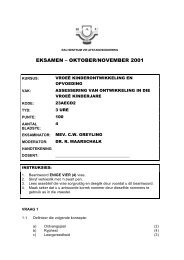randse afrikaanse universiteit - the University of Johannesburg ...
randse afrikaanse universiteit - the University of Johannesburg ...
randse afrikaanse universiteit - the University of Johannesburg ...
You also want an ePaper? Increase the reach of your titles
YUMPU automatically turns print PDFs into web optimized ePapers that Google loves.
KURSUS: B.COM HONNEURS<br />
VAK: BEMARKING VAN DIENSTE<br />
So we had a very interesting time bringing it 500<br />
meters down to <strong>the</strong> railway line.” 3<br />
Restoring <strong>the</strong> carriages posed a challenge <strong>of</strong> a<br />
different kind. Most spares required for <strong>the</strong><br />
restoration work were unavailable, and had to be<br />
made. For this reason it was decided to use wood<br />
for <strong>the</strong> carriages instead <strong>of</strong> steel because <strong>the</strong><br />
former is easier to work with. Fortunately spares<br />
are still available for <strong>the</strong> undercarriage and bogeys<br />
which are made <strong>of</strong> steel. “But <strong>the</strong> electrics are a<br />
problem. We have definitely run out <strong>of</strong> odds and<br />
ends, and I don’t know what we’re going to do<br />
about it yet” Vos admitted in an earlier interview. 4<br />
THE ROVOS RAIL PRODUCT<br />
Rovos Rail is marketed internationally as “The<br />
most luxurious train in <strong>the</strong> world.” 5 The beautifully<br />
restored trains (<strong>the</strong>re are two <strong>of</strong> <strong>the</strong>m) consist <strong>of</strong><br />
up to 21 coaches which can be drawn by ei<strong>the</strong>r<br />
steam, diesel or electric locomotives operating at<br />
various stages <strong>of</strong> <strong>the</strong> journey. The Classic Pride<br />
<strong>of</strong> Africa, boasting a 1940’s style, carries a<br />
maximum <strong>of</strong> 68 passengers. This train is<br />
dedicated to serving <strong>the</strong> route between Victoria<br />
Falls, Pretoria, Cape Town and George/Knysna.<br />
The original Edwardian Pride <strong>of</strong> Africa carries a<br />
maximum <strong>of</strong> 46 passengers, and is mainly<br />
dedicated to serving <strong>the</strong> Pretoria/Komatipoort<br />
route. This train can also be chartered by<br />
individuals or companies for private use. The<br />
trains travel at a speed <strong>of</strong> 40 km/h, ensuring an<br />
unhurried and relaxed atmosphere.<br />
Facilities aboard <strong>the</strong> trains include luxurious<br />
accommodation <strong>of</strong> an unmatched standard,<br />
combining <strong>the</strong> opulence <strong>of</strong> pre-war travel with<br />
subtle modern innovations. Each <strong>of</strong> <strong>the</strong> DeLuxe<br />
(11 m 2 ) or Royal (16m 2 ) Suites has a twin or<br />
double bed, a lounge area and a private en-suite<br />
bathroom with hot water shower, hairdryer, shaver<br />
point, toilet and basin. The bathrooms in<br />
particular are large, and beautifully decorated.<br />
The Royal Suites have a broad balcony from<br />
which passengers can admire <strong>the</strong> scenery, and<br />
are named after colourful Victorian characters<br />
such as Cecil John Rhodes, Barney Barnato and<br />
Alfred Beit, as well as Rohan Vos’s wife An<strong>the</strong>a.<br />
Each suite has a bar fridge, which is filed with an<br />
assortment <strong>of</strong> drinks including a bottle <strong>of</strong><br />
champagne and a bowl <strong>of</strong> fruit. A folder with a<br />
welcoming note from Rohan Vos, an itinerary,<br />
3 Rohan Vos. (1993, March). Getaway, pp. 34-<br />
38, 115.<br />
4 Rohan Vos. (1993, March). Getaway, pp. 34-<br />
38, 115.<br />
5 Rovos Rail: Train Safaris. (1997). Promotional<br />
brochure.<br />
2<br />
Rovos Rail postcards, writing paper and<br />
envelopes, and a comment card are also placed in<br />
every suite. Rovos Rail believes that small things<br />
can make a big impression.<br />
Breakfast, lunch and a formal dinner are served in<br />
<strong>the</strong> charming Victorian atmosphere <strong>of</strong> <strong>the</strong> Dinning<br />
Car. The very impressive Shangani dining car<br />
boasts seven pairs <strong>of</strong> beautifully carved wooden<br />
pillars, with arches flowing down <strong>the</strong> length <strong>of</strong> <strong>the</strong><br />
coach. Art Nouveau light fittings, ceiling fans,<br />
draped curtains and colourful flower arrangements<br />
compliment this. In keeping with tradition,<br />
passengers are still expected to dress for dinner.<br />
At <strong>the</strong> back <strong>of</strong> <strong>the</strong> train one finds yet ano<strong>the</strong>r<br />
surprise: <strong>the</strong> observation car. Enlarged windows<br />
and a completely glassed back end with a small<br />
balcony allows passengers <strong>the</strong> opportunity to<br />
experience some <strong>of</strong> <strong>the</strong> most majestic views<br />
South Africa has to <strong>of</strong>fer. The observation car<br />
seats 32 passengers.<br />
Experienced staff, including laundry staff, kitchen<br />
staff (2 chefs and 2-3 helpers per train), service<br />
staff such as barmen and hostesses are<br />
responsible for serving passengers during <strong>the</strong> trip.<br />
Each hostess is responsible for 4-6 suites, while a<br />
mechanic takes care <strong>of</strong> all <strong>the</strong> technical<br />
requirements. A train manager takes<br />
responsibility for <strong>the</strong> overall functioning <strong>of</strong> <strong>the</strong><br />
train, while <strong>the</strong> deputy manager is responsible for<br />
<strong>the</strong> performance <strong>of</strong> <strong>the</strong> staff on <strong>the</strong> train. Each<br />
employee is issued with <strong>the</strong> Rovos Rail uniform,<br />
which not only makes <strong>the</strong>m more identifiable to<br />
passengers, but also create a pr<strong>of</strong>essional image.<br />
In keeping with <strong>the</strong> spirit <strong>of</strong> travel in bygone days,<br />
<strong>the</strong>re are no televisions or radios on board, and a<br />
cellular phone is available for emergencies only.<br />
Depending on <strong>the</strong> journey, <strong>the</strong> train may stop at<br />
different places <strong>of</strong> special interest. In Kimberley<br />
and Matjiesfontein passengers are transported in<br />
minibuses to places <strong>of</strong> historic significance, while<br />
game drives in fully equipped Land Rovers are<br />
<strong>of</strong>fered when passengers stay over at Londolozi, a<br />
private game reserve in Mpumalanga. On <strong>the</strong> Dar<br />
Es Salaam route organised tours to Zanzibar,<br />
Nairobi, Mt Kilimanjaro, Ngorogoro Crater and <strong>the</strong><br />
Serengeti National Park are arranged.<br />
ROUTES AND PRICE STRUCTURE<br />
Rovos Rail started operating on <strong>the</strong> Pretoria-<br />
Graskop route back in 1989. At <strong>the</strong> time fares<br />
ranged between R5 544 and R7 784, including<br />
GST. When asked about <strong>the</strong> high price, Joyce<br />
Hayward, <strong>the</strong>n marketing manager, explained:<br />
“We have to charge that much to cover our heavy<br />
overheads … And we’re not just <strong>of</strong>fering a train


